When it comes into force the EU’s new digital border system known as EES will register the millions of annual entries and exits of non-EU citizens travelling to the EU/Schengen area, which will cover 29 European countries.
Under the EU Entry/Exit System (EES), non-EU residents who do not require a visa will have to register their biometric data in a database that will also capture each time they cross an external Schengen border.
Passports will no longer be manually stamped, but will be scanned. However, biometric data such as fingerprints and facial images will have to be registered in front of a guard when the non-EU traveller first crosses in to the EU/Schengen area.
Naturally there are concerns the extra time needed for this initial registration will cause long queues and tailbacks at the border.
To help alleviate those likely queues and prevent the subsequent frustration felt by travellers the EU is developing a new smartphone app.
READ ALSO: What will the EES passport system mean for foreigners living in Europe?
The importance of having a working app was summed up by Uku Särekanno, Deputy Executive Director of the EU border agency Frontex in a recent interview.
“Initially, the challenge with the EES will come down to the fact that travellers arriving in Europe will have to have their biographic and biometric data registered in the system – border guards will have to register four of their fingerprints and their facial image. This process will take time, and every second really matters at border crossing points – nobody wants to be stuck in a lengthy queue after a long trip.”
But there is confusion around what the app will actually be able to do, if it will help avoid delays and importantly when will it be available?
So here’s what we know so far.
Who is developing the app?
The EU border agency Frontex is currently developing the app. More precisely, Frontex is developing the back-end part of the app, which will be made available to Schengen countries.
“Frontex is currently developing a prototype of an app that will help speed up this process and allow travellers to share some of the information in advance. This is something we are working on to support the member states, although there is no legal requirement for us to do so,” Uku Särekanno said in the interview.
Will the 29 EES countries be forced to use the app?
No, it is understood that Frontex will make the app available on a voluntary basis. Each government will then decide if, when and where to use it, and develop the front-end part based on its own needs.
This point emerged at a meeting of the House of Commons European scrutiny committee, which is carrying out an inquiry on how EES will impact the UK.
What data will be registered via the app?
The Local asked the European Commission about this. A spokesperson however, said the Commission was not “in a position to disclose further information at this stage” but that travellers’ personal data “will be processed in compliance with the high data security and data protection standards set by EU legislation.”
According to the blog by Matthias Monroy, editor of the German civil rights journal Bürgerrechte & Polizei/CILIP the Frontex app will collect passengers’ name, date of birth, passport number, planned destination and length of stay, reason for travelling, the amount of cash they carry, the availability of a credit card and of a travel health insurance. The app could also allow to take facial images. It will then generate a QR code that travellers can present at border control.
This, however, does not change the fact that fingerprints and facial images will have to be registered in front of a guard at the first crossing into the Schengen area.
So given the need to register finger prints and facial images with a border guard, the question is how and if the app will help avoid those border queues?
When is the app going to be available?
The answer to perhaps the most important question is still unclear.
The Commissions spokesperson told The Local that the app “will be made available for Schengen countries as from the Entry/Exit System start of operations.” The planned launch date is currently October 6th, but there have been several delays in the past and may be another one.
The UK parliamentary committee heard that the prototype of the app should have been ready for EU member states in spring. Guy Opperman, Under-Secretary of State at the UK Department for Transport, said the app will not be available for testing until August “at best” and that the app will not be ready in time for October. The committee previously stated that the app might even be delayed until summer 2025.
Frontex’s Särekanno said in his interview: “Our aim is to have it ready by the end of the summer, so it can then be gradually integrated into national systems starting from early autumn”.
READ ALSO: How do the EES passport checks affect the 90-day rule?
Can the system be launched if the app is not ready?
Yes. The European Commission told The Local that “the availability of the mobile application is not a condition for the Entry/Exit System entry into operation or functioning of the system. The app is only a tool for pre-registration of certain types of data and the system can operate without this pre-registration.”
In addition, “the integration of this app at national level is to be decided by each Schengen country on a voluntary basis – as there is no legal obligation to make use of the app.”
And the UK’s transport under secretary Guy Opperman sounded a note of caution saying the app “is not going to be a panacea to fix all problems”.
When the app will be in use, will it be mandatory for travellers?
There is no indication that the app will become mandatory for those non-EU travellers who need to register for EES. But there will probably be advantages in using it, such as getting access to faster lanes.
As a reminder, non-EU citizens who are resident in the EU are excluded from the EES, as are those with dual nationality for a country using EES. Irish nationals are also exempt even though Ireland will not be using EES because it is not in the Schengen area.
Has the app been tested anywhere yet?
Frontex says the prototype of the app will be tested at Stockholm’s Arlanda Airport, in Sweden. Matthias Monroy’s website said it was tested last year at Munich Airport in Germany, as well as in Bulgaria and Gibraltar.
According to the German Federal Police, the blog reports, passengers were satisfied and felt “prepared for border control”.
This article is published in cooperation with Europe Street News.






 Please whitelist us to continue reading.
Please whitelist us to continue reading.
It seems like this is very similar to the Global Entry system that the United States uses. We have found it to be incredibly easy to use.
I’m a USA citizen. I would like to know if the EES will link to the USA Global Entry program? All the biometric data has already been collected for people enrolled in that program. Thank you.